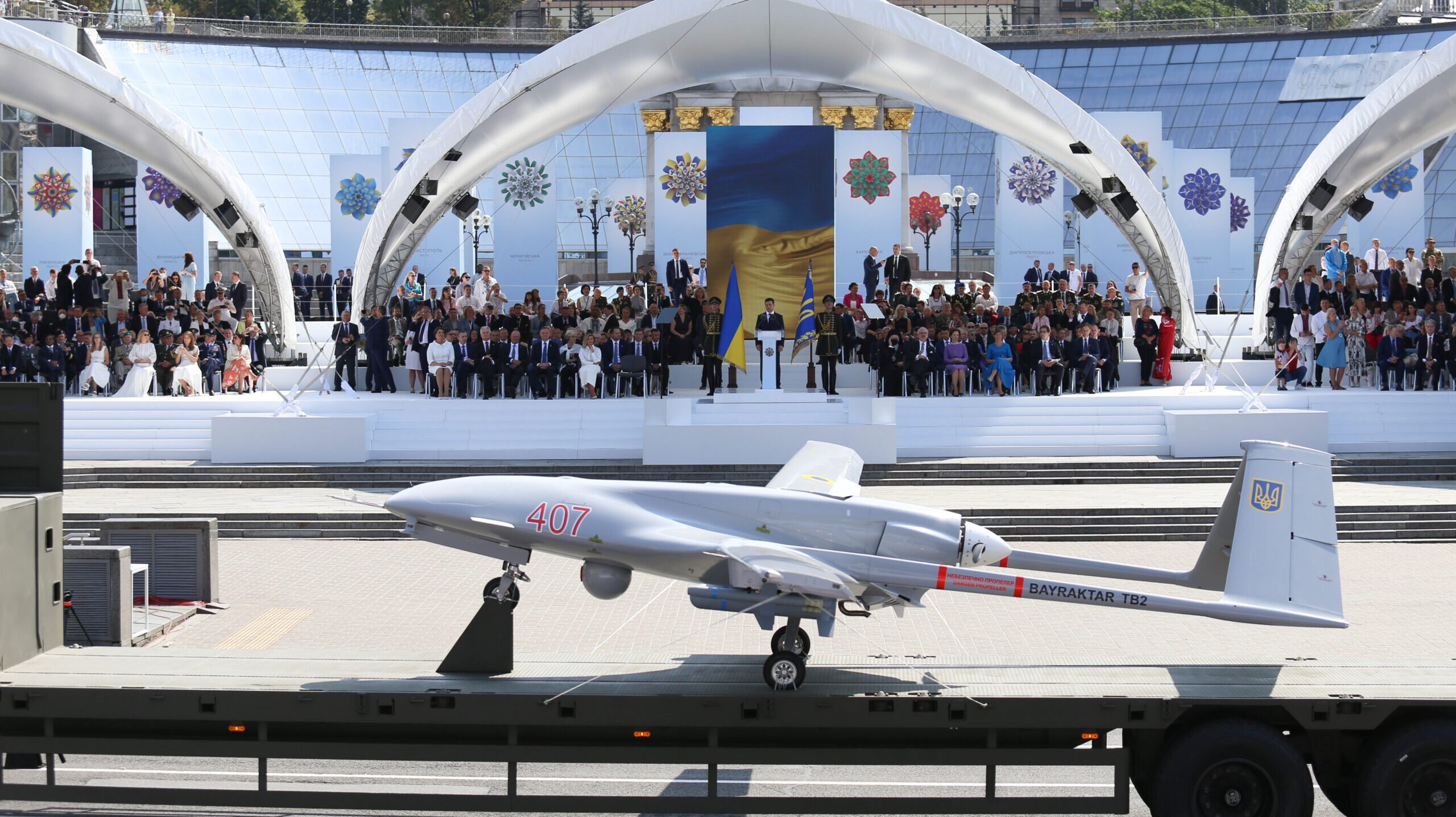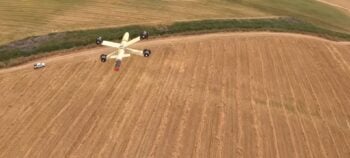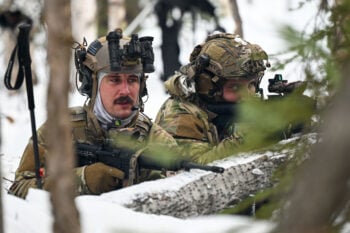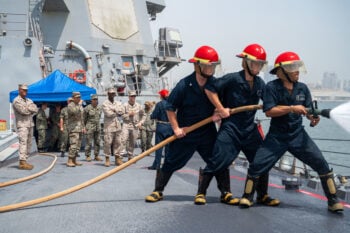
A Turkish-made Bayraktar TB2 drone is seen during the Ukrainian Independence Day parade in Kyiv in 2021. (Mohammad Javad Abjoushak/SOPA Images/LightRocket via Getty Images)
BEIRUT — When Russia’s invasion of Ukraine began in February 2022, an unlikely technological folk hero emerged as a symbol of Ukrainian resistance: the Turkish-made Bayraktar TB2 unmanned aerial vehicle. The drone became intrinsically tied to the public’s perception of Ukraine’s underdog fight against Moscow, to the point that weeks into the fight a government-organized song about the system had become an international sensation.
But as the war crosses into its nineteenth month, the TB2 has largely faded from the conversation — or at least it had, until the US government announced on Oct. 5 that an American F-16 had shot down a Turkish drone over Syria, which Politico reported was a TB2.
It’s an awkward situation, with one NATO ally having shot down the aircraft of another. But it has brought Turkish drones, of which the TB2 produced by Turkish firm Baykar is the most high-profile, back into the spotlight, and raised the question of what the drone has been doing in Ukraine as it has faded from the spotlight.
Analysts tell Breaking Defense that there has been a shift in the TB2’s use as the direct result of Russia’s change in air defense tactics over the course of the war.
“TB2 was a successful drone at the early stages of the war when the Russian military’s air defense and EW [electronic warfare] was relatively disorganized. It was also a very helpful weapon for competing in the information space against the Russian invasion, with strike videos shared widely on social media,” Samuel Bendett, an AI and unmanned systems expert at US-based CNA research organization, told Breaking Defense.
But as Russia became more organized, particularly as it dug in on defensive positions after the initial surge of the invasion, its use of air defense and EW capabilities turned the TB2 from the pointy end of Ukraine’s spear into the kind of target that Moscow’s forces could safely challenge.
“By design, TB2 is a relatively large target that does not fly very fast, and can be vulnerable to sophisticated defenses,” Bendett said.
Can Kasapoglu, a senior fellow at the US-based Hudson Institute and Director of Defense Research at the Istanbul-based Edam think tank, told Breaking Defense that the TB2’s best days may be behind it. “Every weapon system is useful within a specific context and under certain military circumstances. The TB2 was the most effective when the Russian supply lines were over-stretched in a multi front, large-scale and stumbling invasion campaign,” Kasapoglu said.
New Uses, New Missions
Both analysts noted that as the war has shifted, the use of smaller drones has become more commonplace — and a host of cheap, off the shelf UAVs that can be deployed by forces on the ground are simply easier to use for basic ISR or targeting than the highly-technical TB2s.
And yet, both also agree that the usefulness of the TB2 isn’t done.
“TB2 has a sophisticated sensor package and can guide other assets like drones and missiles to targets while [staying] out of range of many Russian defensive systems. And no air or EW defenses is absolute — there will be gaps that can be exploited by different classes of aerial assets, including TB2,” Bendett said.
In the days before the US downing, Baykar declined to comment for this story.
While media coverage of the TB2 may have dropped, there are reasons to believe the drone has continued to operate inside Ukrainian territory, and may be filling in less public missions.
From his point of view, Bendett saw that it’s hard to estimate real TB2 effectiveness just by looking at public data and social media posts that are always selective with content. He noted that its highly likely that TB2s are flown in many missions that are simply not advertised, for security reasons.
Kasapoglu said that open source evidence suggests that they are used in kinetic strike roles, and the drone apparently played a key role in a strike earlier this month that took out a Russian patrol boat. “However, we do not have the entire battle picture, So there might probably be other TB2 sorties for intelligence gathering & target acquisition,” he told Breaking Defense.
The TB2 may also have become a victim of its own success. Given the global attention on the drones, the Ukrainian government may be concerned about the propaganda win that could come if the Russians were able to down one of the Turkish systems.
“Under heavy Russian electronic warfare threat and intensive air defenses, it seems the Ukrainian General Staff is keeping the TB2s as a strategic reserve force that should be employed in favorable settings,” Kasapoglu said.
The exact number of TB2 drones in Ukraine’s arsenal is unknown. Available media reports say Ukraine has received around 50 drones since the start of the war, although Kasapoglu cautioned that figure may be the total number of systems Ukraine has received over all, including ones that are no longer operable. (At the start of the war, Kyiv owned around 20 TB2s.)
And perhaps the biggest sign that the TB2 is going to remain in play in the region: the company’s ongoing plans to build a TB2 factory inside Ukraine.
“The plan to build a UAV factory in Ukraine is still underway, with plans to complete it by October 2024. Of course, operational security will be key for the finalization of the project. Although still in progress, the initiative already had a significant impact on Turkish—Ukrainian military-strategic relations,” Kasapoglu said.
He pointed that some examples in this regard include the inclusion of Baykar’s latest drone AKINCI in the co-production deal and the agreement to power the Turkish unmanned combat aircraft KIZILELMA with Ukrainian Ivchenko-Progress engines.
TAI exec claims 20 Turkish KAAN fighters to be delivered in 2028
Temel Kotil, TAI’s general manager, claimed that the domestically-produced Turkish jet will outperform the F-35 Joint Strike Fighter.


























